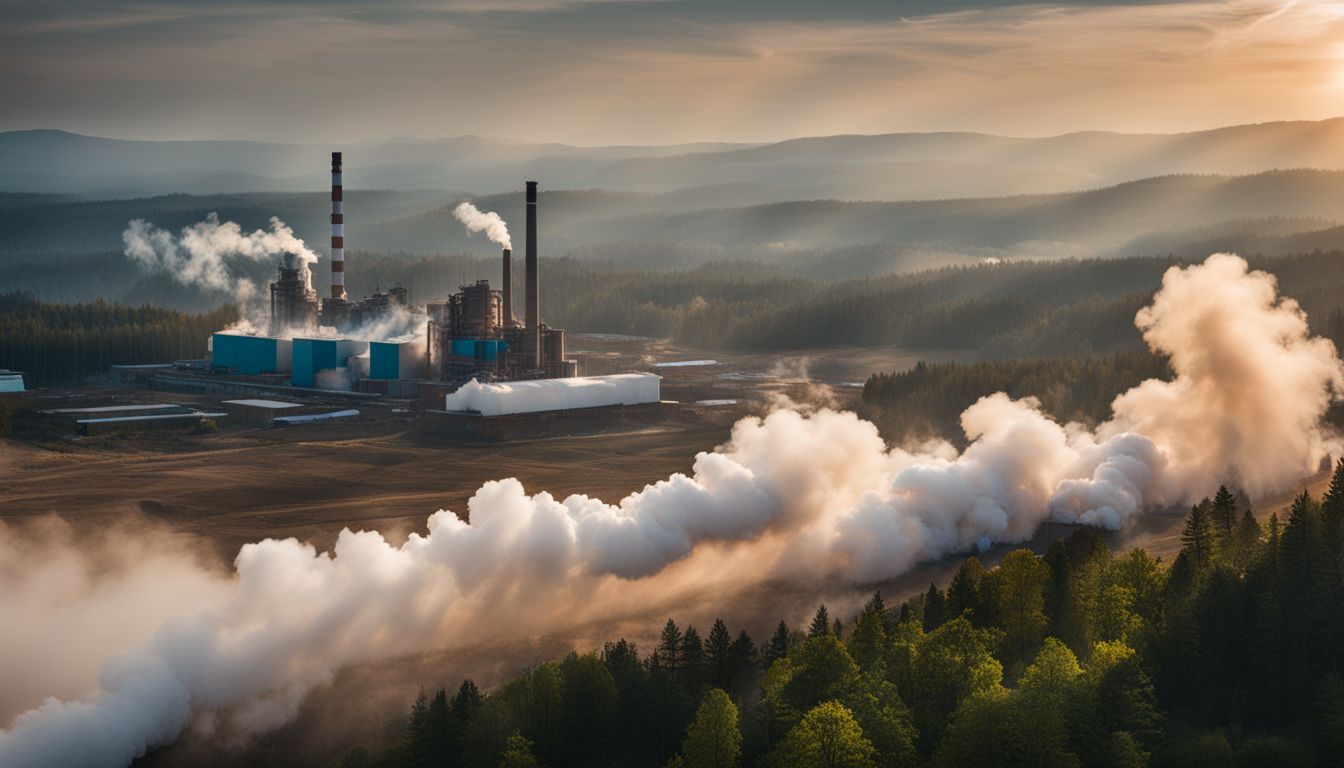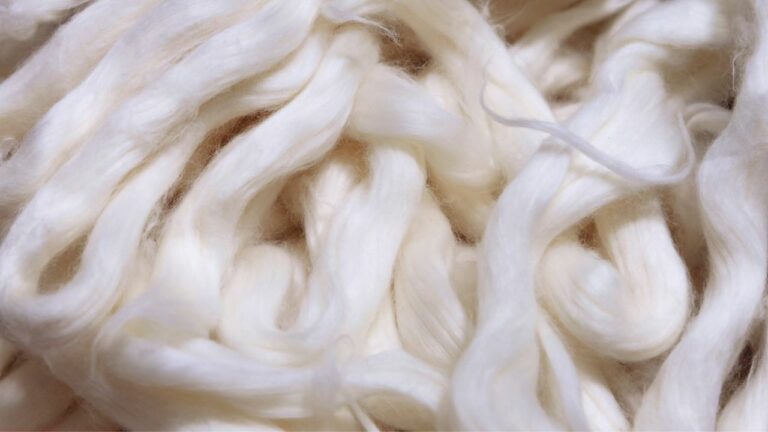Understanding Viscose Fabric: Sustainability and Environmental Impact Explained
Navigating the complexity of fabric sustainability can be overwhelming. Did you know viscose, often praised for its affordability and durability in the fashion world, isn’t as eco-friendly as you might think? This article will demystify everything about viscose fabric: from its manufacturing process to its eventual disposal, showing you how it impacts our environment at each stage.
Ready to become an informed consumer? Let’s unravel this thread together.
Key Takeaways
- Viscose fabric, made from wood pulp or bamboo, is not as eco-friendly as it seems due to its energy-intensive manufacturing process and the sourcing of wood pulp from endangered forests.
- Important factors to consider when assessing the sustainability of viscose fabrics include responsible raw material sourcing, environmentally friendly manufacturing processes, carbon emissions during transportation, and proper disposal methods.
- To buy viscose fabrics more sustainably: look for certifications like FSC or SFI; choose brands that prioritize responsible production and use closed-loop systems; opt for durable fabrics; support sustainable brands with transparent supply chains; consider alternative fabrics like organic cotton or hemp.
What is Viscose Fabric?
Viscose fabric is a type of textile made from cellulose-based materials such as wood pulp or bamboo. It is produced through a manufacturing process that involves chemically treating the raw materials to create fibers that can be spun into yarn and then woven into fabric.
This production process has significant environmental impacts, which will be discussed further in the blog.
Manufacturing process and materials used
Viscose fabric is made in a very special way. First, wood pulp is taken from trees. This pulp comes from all types of trees, even ones that may be at risk. Next, the pulp goes through a chemical process. This uses a lot of energy and can harm our planet. After this, the pulp turns into a soft material we know as viscose. Viscose feels nice to touch and looks good too. But making it puts a big mark on our world. It’s not as green as it might seem at first glance.
Environmental impact of viscose fabric production

Additionally, some wood pulp used in the production of viscose is sourced from endangered forests, raising concerns about deforestation and loss of biodiversity. While viscose fabric is biodegradable and made from renewable resources, its production still poses sustainability challenges that need to be addressed.
Sustainability of Viscose Fabrics

Viscose fabrics undergo a life-cycle analysis to assess their sustainability, considering factors such as sourcing raw materials, manufacturing process and energy consumption, transportation, carbon footprint, usage, and end-of-life considerations.
Life-cycle analysis and assessment of sustainability

To understand the sustainability of viscose fabrics, it is important to conduct a life-cycle analysis. This means evaluating the environmental impact of each stage, from sourcing raw materials to manufacturing, transportation, usage, and end-of-life considerations.
The production process of viscose fabric requires a significant amount of energy, often derived from fossil fuels, which contributes to its environmental footprint. Additionally, some wood pulp used for viscose production comes from endangered forests, raising concerns about deforestation and biodiversity loss.
It is crucial to consider these factors when assessing the overall sustainability of viscose fabrics.
Sourcing raw materials and impact on forests
The raw materials used in the production of viscose fabric come from wood pulp, often obtained from trees like eucalyptus and beech. Unfortunately, there are concerns about the sustainability of this sourcing process.
Some wood pulp comes from endangered forests, which has a negative impact on our forests and biodiversity. This raises questions about the environmental responsibility of using these materials for viscose fabric production.
It is important for manufacturers to prioritize responsible sourcing practices and choose suppliers that adhere to sustainable forestry standards to minimize the impact on our precious forests.
Manufacturing process and energy consumption

Viscose fabric is made through a chemical process called “viscose method.” This process involves treating cellulose from trees with chemicals and turning it into a solution. The solution is then spun into fibers, which are used to create the fabric.
Unfortunately, this manufacturing process requires a lot of energy. Most of this energy comes from fossil fuels like coal or natural gas, which contribute to greenhouse gas emissions and climate change.
It’s important to note that the high energy consumption during the manufacturing process contributes significantly to the environmental footprint of viscose fabric production.
Transportation and carbon footprint

Viscose fabric production not only consumes a lot of energy but also contributes to carbon emissions through transportation. The raw materials, such as wood pulp, are often sourced from distant locations, resulting in long transportation distances and increased carbon footprint.
This transportation process adds to the overall environmental impact of viscose fabric production. It’s important to consider these factors when assessing the sustainability of viscose fabrics and the fashion industry as a whole.
Usage and end-of-life considerations

Viscose fabric is commonly used in clothing and home textiles due to its affordability and versatility. However, there are important usage and end-of-life considerations to keep in mind.
When using viscose fabric, it is best to follow the care instructions provided by the manufacturer to ensure its longevity. Avoid overwashing or subjecting it to harsh conditions that can cause damage.
When it comes to disposal, it’s important to remember that while viscose is biodegradable, the chemicals used during production might not be environmentally friendly. Therefore, try donating or repurposing items made from viscose fabric instead of throwing them away.
Additionally, recycling initiatives for viscose fabrics are still limited compared to other materials like cotton or polyester. This means that proper recycling infrastructure may not be readily available in many areas.
Buying Viscose Fabrics More Sustainably

To buy viscose fabrics more sustainably, it is important to consider tips for sustainable purchasing and identify sources that prioritize responsible production and natural materials.
Tips for sustainable purchasing

Here are some tips to help you make more sustainable purchasing decisions when buying viscose fabrics:
- Look for certifications: Choose viscose fabrics that have been certified by third-party organizations, such as the Forest Stewardship Council (FSC) or the Sustainable Forestry Initiative (SFI). These certifications ensure that the raw materials used in production come from responsibly managed forests.
- Check for eco-friendly processes: Seek out brands or manufacturers that use environmentally friendly manufacturing processes. Look for fabrics that have been produced using closed-loop systems, which recycle water and chemicals to minimize waste and pollution.
- Consider durability: Opt for high-quality viscose fabrics that are well-made and designed to last. By choosing durable materials, you can reduce the need for replacement and ultimately decrease your environmental footprint.
- Buy from sustainable brands: Research and support brands that prioritize sustainability in their production practices. Look for companies with transparent supply chains and a commitment to reducing their environmental impact.
- Explore alternative options: Consider other sustainable fabric choices, such as organic cotton or hemp, as alternatives to viscose fabric. These materials often have lower environmental footprints and may be a better choice depending on your specific needs.
Identifying sustainable viscose fabric sources

To identify sustainable viscose fabric sources, it is important to look for certifications such as FSC or PEFC that ensure responsible sourcing of raw materials. These certifications indicate that the wood pulp used in the production of viscose comes from sustainably managed forests.
Additionally, some brands and manufacturers have started to adopt closed-loop systems, where chemicals used in the manufacturing process are recycled and reused. By supporting these brands and manufacturers, you can contribute to a more sustainable production of viscose fabrics.
Importance of choosing sustainable fabrics

Choosing sustainable fabrics is of utmost importance in today’s fashion industry. By opting for fabrics that have a lower environmental impact, we can make a positive difference. Sustainable fabrics, such as organic cotton and recycled polyester, help reduce the use of harmful chemicals and minimize water consumption during production.
They also ensure responsible sourcing of raw materials and promote the use of renewable resources. Moreover, choosing sustainable fabrics encourages companies to adopt more eco-friendly practices throughout the entire supply chain.
It allows us to support brands that prioritize sustainability and contribute to creating a greener future for our planet.
Benefits and Drawbacks of Viscose Fabric

Viscose fabric offers breathability and comfort, but it also has drawbacks such as its tendency to shrink and lose shape when washed.
Pros and cons of using viscose fabric

Viscose fabric, like other materials, has its unique set of benefits and drawbacks. These can impact your decision whether to choose this fabric or not, so understanding them is crucial. Here’s a summary of the pros and cons of using viscose fabric:
| Pros | Cons |
|---|---|
| Viscose fabric is biodegradable, which means it doesn’t contribute to the growing problem of microplastic pollution like some synthetic fabrics. | The manufacturing process of viscose fabric is energy-intensive and often uses energy from non-renewable sources. |
| This fabric is made from renewable plant materials, adding to its appeal as an environmentally friendly option. | Some of the wood pulp used in making viscose comes from endangered forests, causing deforestation and posing a threat to biodiversity. |
| Viscose fabric is often marketed as a sustainable alternative to cotton and polyester in the fashion industry due to its durability and affordability. | Despite being made from renewable resources, the overall environmental impact of producing viscose is quite high. |
| Compared to fully synthetic fabrics, viscose is more sustainable because it is biodegradable. | The chemical process used in producing viscose fabric can have harmful effects on the environment. |
| Viscose fabric is generally softer and more breathable than synthetic fabrics, which can make clothes more comfortable. | Viscose fabric tends to be less durable than other materials, which means garments made from it may not last as long and could contribute to a higher environmental impact over time. |
Comparisons to other fabrics (cotton, polyester)
Viscose fabric is often compared to cotton and polyester. Compared to cotton, viscose is generally considered less sustainable due to the intensive manufacturing process and the potential sourcing of wood pulp from endangered forests. However, it is more sustainable than fully synthetic fabrics like polyester because it is biodegradable. Viscose fabric also tends to be cheaper and more durable than cotton. When comparing viscose to polyester, both materials have their own sustainability challenges. While viscose has a higher environmental impact during production, polyester has a larger carbon footprint overall due to its non-biodegradable nature. It’s important to consider these factors when making choices about which fabrics are more environmentally friendly in the fashion industry.
Conclusion
Viscose fabric may not be as sustainable as it is often marketed to be. Its production process consumes a lot of energy and can contribute to deforestation. While it is biodegradable, its durability may lead to more frequent replacements, increasing its environmental impact over time.
It’s essential to consider the entire lifecycle of viscose fabric when assessing its sustainability.
FAQs
1. Is viscose fabric sustainable?
No, viscose fabric is not inherently sustainable as it is made from trees that are often sourced unsustainably. However, there are more sustainable alternatives such as lyocell and modal.
2. What is the environmental impact of producing viscose fabric?
The production of viscose fabric involves harmful chemicals and water-intensive processes, which can contribute to pollution and depletion of natural resources.
3. Can I recycle or compost viscose fabric?
Viscose fabric can be difficult to recycle due to its mixed composition of cellulose fibers. Composting may be possible if the fabric is 100% natural without any synthetic additives.
4. Are there any eco-friendly alternatives to viscose fabric?
Yes, there are eco-friendly alternatives to viscose fabric such as organic cotton, hemp, bamboo, or fabrics made from recycled materials like polyester or nylon.







